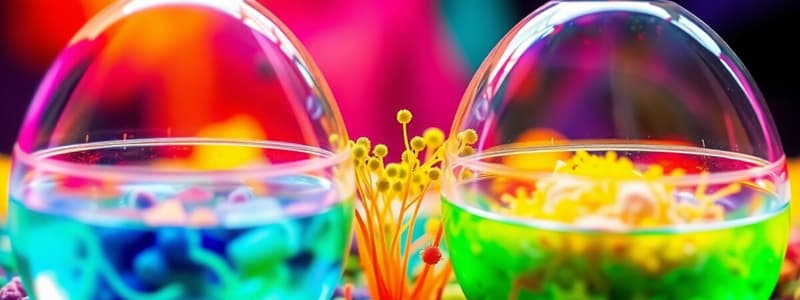Podcast
Questions and Answers
Microorganisms require a source of metabolic energy for synthesizing macromolecules and maintaining essential chemical gradients.
Microorganisms require a source of metabolic energy for synthesizing macromolecules and maintaining essential chemical gradients.
True (A)
Agar, a polysaccharide extracted from certain red algae, is a common gelling agent used in microbiological media.
Agar, a polysaccharide extracted from certain red algae, is a common gelling agent used in microbiological media.
True (A)
The dilution method for isolating microorganisms in pure culture involves increasing the density of microorganisms through serial dilution.
The dilution method for isolating microorganisms in pure culture involves increasing the density of microorganisms through serial dilution.
False (B)
Cultivating microorganisms requires the control of factors such as pH, temperature, aeration, and salt concentration.
Cultivating microorganisms requires the control of factors such as pH, temperature, aeration, and salt concentration.
Fermentation, respiration, and photosynthesis are the only three known mechanisms for generating metabolic energy in microorganisms.
Fermentation, respiration, and photosynthesis are the only three known mechanisms for generating metabolic energy in microorganisms.
In the plating method, a single cell is placed on a solid medium, and if conditions are suitable, it will grow into a visible colony.
In the plating method, a single cell is placed on a solid medium, and if conditions are suitable, it will grow into a visible colony.
Microorganisms can only survive through one of the three primary mechanisms for generating metabolic energy: fermentation, respiration, or photosynthesis.
Microorganisms can only survive through one of the three primary mechanisms for generating metabolic energy: fermentation, respiration, or photosynthesis.
The population of microorganisms in the biosphere is constantly growing, with no significant death rates.
The population of microorganisms in the biosphere is constantly growing, with no significant death rates.
The lag phase of bacterial growth is characterized by rapid cell division and exponential growth.
The lag phase of bacterial growth is characterized by rapid cell division and exponential growth.
In the exponential phase, bacterial cells divide at a constant rate, leading to exponential population growth.
In the exponential phase, bacterial cells divide at a constant rate, leading to exponential population growth.
The decline phase of bacterial growth results in the accumulation of nutrients and the stability of the population.
The decline phase of bacterial growth results in the accumulation of nutrients and the stability of the population.
The growth rate in the maximum stationary phase equals the death rate, maintaining a stable population size.
The growth rate in the maximum stationary phase equals the death rate, maintaining a stable population size.
All microorganisms grow at the same rate regardless of environmental conditions.
All microorganisms grow at the same rate regardless of environmental conditions.
Bacterial cells can be kept in exponential phase by transferring them into fresh medium while still growing.
Bacterial cells can be kept in exponential phase by transferring them into fresh medium while still growing.
During the lag phase, bacteria synthesize the necessary enzymes and proteins for growth.
During the lag phase, bacteria synthesize the necessary enzymes and proteins for growth.
Toxic waste accumulation only occurs during the exponential phase of bacterial growth.
Toxic waste accumulation only occurs during the exponential phase of bacterial growth.
Flashcards
Cultivation of microorganisms
Cultivation of microorganisms
The process of propagating organisms by providing proper environmental conditions and nutrients.
Metabolic energy generation
Metabolic energy generation
The three major mechanisms for generating energy: fermentation, respiration, and photosynthesis.
Nutritional demands
Nutritional demands
Microorganisms vary in their required nutrients and sources of metabolic energy.
Cultivation methods
Cultivation methods
Signup and view all the flashcards
Plating method
Plating method
Signup and view all the flashcards
Dilution method
Dilution method
Signup and view all the flashcards
Agar
Agar
Signup and view all the flashcards
Survival in natural environment
Survival in natural environment
Signup and view all the flashcards
Microbial Survival
Microbial Survival
Signup and view all the flashcards
Definition of Growth
Definition of Growth
Signup and view all the flashcards
Unicellular Growth
Unicellular Growth
Signup and view all the flashcards
Bacterial Growth Curve
Bacterial Growth Curve
Signup and view all the flashcards
Lag Phase
Lag Phase
Signup and view all the flashcards
Exponential Phase
Exponential Phase
Signup and view all the flashcards
Stationary Phase
Stationary Phase
Signup and view all the flashcards
Death Phase
Death Phase
Signup and view all the flashcards
Study Notes
Cultivation of Microorganisms
- Cultivation is the process of growing organisms by providing the right environmental conditions.
- Organisms need energy to make molecules and maintain their internal chemical balance.
- Nutrients must be available in a usable form.
- Factors like nutrients, pH, temperature, oxygen levels, salt concentration, and ion strength need control during growth.
- Three main energy generation mechanisms are fermentation, respiration, and photosynthesis.
- Cultivation is crucial for research, diagnostics, industrial applications, and biotechnology.
Cultivation Methods
- Two key factors are choosing the right growth medium and isolating individual species (pure culture).
- Fundamental goals in cultivation include growing a specific type of organism, determining the number and type of organisms in a sample, and isolating specific organisms from a larger sample.
- Microorganisms can be isolated using methods like plating or dilution.
Plating Method
- By placing a small number of cells on a solid medium (like agar) individual cells will grow into isolated colonies.
Dilution Method
- This method reduces the density of organisms in a sample through serial dilution.
- Samples of the dilutions are placed on solid media to isolate individual cells, each of which grow into a pure colony.
Survival of Microorganisms in the Natural Environment
- Growth is balanced by death in the biosphere, maintaining roughly constant populations.
- Survival depends on having a source of nutrients and outcompeting other organisms.
Meaning of Growth
- Growth is the increase in the overall components (size or mass) of an organism.
- In single-celled organisms, growth is the expansion or increase in cell numbers.
The Growth Curve
- The growth curve represents bacterial population dynamics in a closed system with fixed nutrients and environmental conditions.
- Four distinct phases are: lag phase, exponential growth phase, stationary phase, and death phase.
The Lag Phase
- Bacteria adapt to new conditions. Minimal or no division occurs, but metabolic activity does increase.
The Exponential/Logarithmic Phase
- Cells divide at a constant rate, causing a rapid increase in population size.
- Bacteria are highly active metabolically.
The Stationary Phase
- Growth slows as nutrients are used up and waste accumulates.
- New cell production equals cell death, leading to a stable population size.
The Death/Decline Phase
- Cell numbers drop exponentially as nutrients become scarce and toxins accumulate.
- Some organisms enter a dormant state or form spores to survive harsh conditions.
Studying That Suits You
Use AI to generate personalized quizzes and flashcards to suit your learning preferences.




